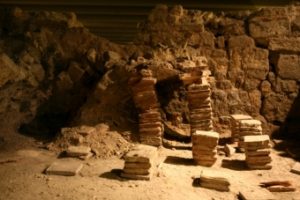
History of the archaeological crypt and excavations
Converted in 1980 under the square in front of Notre-Dame de Paris cathedral to display archaeological remains discovered during excavations from 1965 to 1972, the crypt provides a unique overview of urban and architectural development of the Île de la Cité, the historical heart of Paris. Visitors can travel back in time by discovering successive buildings erected on the site from Ancient Times to the twentieth century and walk through ancient ruins on which mediaeval and classical remains are superimposed. The aim of the tour is to provide a better understanding of how the city has been in a continuous state of reconstruction for over 2,000 years by revealing its various archaeological layers.
Timeline
The Gallo-Roman town of Lutetia began to develop on the left bank of the Seine in the reign of Augustus (27 BC to 14 AD). This site was occupied by the Gaulish tribe, the Parisii, whose name features on coins recovered fromthe river Seine. In the first quarter of the first century AD, several small islands were joined together to form the current Île de la Cité.
From the middle of the third century right up until the fifth century AD, Lutetia which was threatened by the first Germanic invasions, was a strategic site for the defence of the Roman Empire against the barbarians. The Île de la Cité was fortified in 308, becoming the active centre of the city and the settlement on the left bankwas partially abandoned.
The Middle Ages saw the rise of development focused around the cathedral, whose construction began in 1163. This included the creation of a new street, the rue Neuve Notre-Dame, in line
with the central great door of the cathedral, the reconstruction of theHôtel-Dieu hospital to the South of the cathedral square and the construction of buildings and churches.
In the eighteenth century, many mediaeval buildings were destroyed to ease traffic and improve sanitation in the Île de la Cité. The squarewas extended, the rue Neuve Notre-Dame was widened and the Hospice des Enfants-Trouvés foundling hospital was built.
In the nineteenth century, the city prefect, Haussmann, carried out a radical programme of urban restructuring, destroying many old buildings and lanes. Barracks (which are now the police headquarters) were erected at the back of the square, in addition to the currentHôtel–Dieu on the side of the square. The current layout of the square is the result of these major changes.